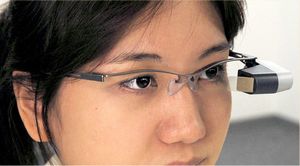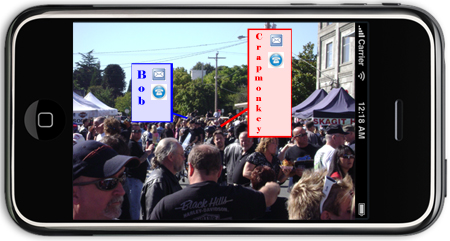
The above equation intends to show some of the key factors leading to explosive growth of augmented reality scenarios. Augmented reality refers to supplementing the real world with contextual computer generated information. While the concept of augmented reality is not new, the ability to “take it with you” is just becoming economical. The devices we carry every day (iphones, smartphones) will get smarter and more powerful, the bandwidth connecting us to the net will continue to increase, and the data being crunched for us in the cloud will continue to become more relevant.
Already, the GPS information in iphones is changing the way people interact with the world around them. Turn-by-turn directions are combining your location information with map data to get you where you wish to go. Smart applications provide details about real estate by using GPS to understand which property sits in front of you. Social networks can be updated with the click of a button to let your friends know where you are. Even so, in a few years we will shrug when we think about how primitive the technology was at this stage.
As I write this, applications are being authored that combine the camera, orientation, and GPS information from the phone with data in the cloud to provide rich information about every day things. Just by pointing the camera on your phone to a sculpture in the park, you will get detailed information delivered to your screen about the art and the artist. Pointing at a restaurant might reveal the day’s dinner and happy hour specials, the wait time for a table, and then provide you a way to place your order as you make your approach. New in town and not sure where to get a bite? Point your device down the street and GPS combined with image recognition will present you with rich data about the establishments that lie ahead of you. In order to make sense of the enormous amount of data, the information will be easily filterable (Food, Italian, Romantic – for example) . Many different devices will provide this functionality and it will become clear that the hardware at your hip is much more than a phone.
 Eventually, companion devices such as smart-glasses (Retinal Imaging Display), will enter the marketplace. These glasses will connect to your device via technologies like Bluetooth to allow for more convenient access to your information. Think of it as the way Terminator viewed the world, only without the all the red tint and orders to kill people. Information at your fingertips will become information at your pupils. Voice recognition will allow you to easily navigate through the data that is being drawn onto the lenses of your eyes. Likewise, content will be very interactive, allowing you to receive and send information to the people and places that stand before you.
Eventually, companion devices such as smart-glasses (Retinal Imaging Display), will enter the marketplace. These glasses will connect to your device via technologies like Bluetooth to allow for more convenient access to your information. Think of it as the way Terminator viewed the world, only without the all the red tint and orders to kill people. Information at your fingertips will become information at your pupils. Voice recognition will allow you to easily navigate through the data that is being drawn onto the lenses of your eyes. Likewise, content will be very interactive, allowing you to receive and send information to the people and places that stand before you.
This brings me to the “people” part of this future. The dawn of augmented reality is neatly aligned with the maturing of social media. The data crunching cloud is not only taking in everything it can about where you are and what you’re looking at, it’s correlating it with everything it knows about you through your social networks, online profiles, search histories, and so on.
Content you are interested in will reach out to you in the form of real time alerts to let you know you are in the vicinity of something you’d be interested in (end-user customizable of course). When you pass a comic book store that has the rare issue of Spider Man you’ve been looking for on ebay – an alert notifies you. As you walk through downtown Seattle, you’re notified of an audio walking tour that can be streamed in real time to your ear as you pass monuments and places of interest. When you walk into a party or concert, your data is correlated with others in your social networks to show you where your friends are in a crowded room or auditorium. It will be as easy to find someone in a crowd and send a direct message to their ear as it is to send a direct message on Twitter today.
The device you carry with you will become your extended sense of site and sound (and maybe more) and the data rich, processor heavy cloud will become the distributed machine that is organizing information, processing it and serving it up. You may think this sounds overwhelming and perhaps even annoying. In fact, you’re probably right. But rest assured… though it may be too much information for you to stomach, your kids are going to love it.
Want to learn more? Check out the Layar platform for one approach or Tonchidot for another.
Note: This post was originally published for the CrapMonkey Podcast in 2009.

